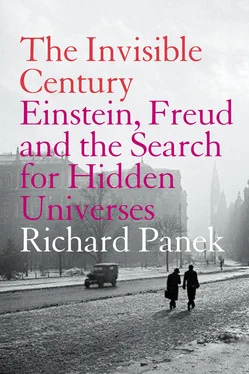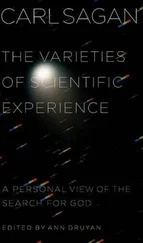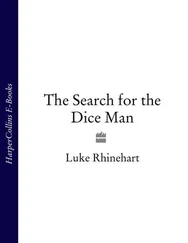In retrospect, though, any such earlier efforts to reduce the workings of the inner universe to a series of cause-and-effect laws were doomed. These would-be Newtons couldn’t have known it at the time, but they didn’t yet have access to a Galilean equivalent of neuroanatomical data—the moons, planets, and stars of the inner universe—to provide their speculations with a solid empirical foundation.
Did Freud? It was tempting for him to think so. It would have been tempting for anyone in his position to think so—not only because it’s always tempting for an ambitious intellect to think that the generation into which it’s fortunate enough to be born is the one in possession of just enough information to settle a question that has thwarted the great thinkers since antiquity but because the state of neuroanatomical knowledge at the close of the nineteenth century was different from any other period in the history of science. In fact, in 1894—only five years after Ramón y Cajal’s discovery that fibers from central nerve cells contact, not connect, and only three years after Waldeyer developed the neuron theory—one of Freud’s former instructors and colleagues from his laboratory days, Sigmund Exner, published his own attempt at a comprehensive neuroanatomy, Entwurf zu einer physiologischen Erklärung der psychischen Erscheinungen ( Draft Toward a Physiological Explanation of the Psychological Features ).
Like most physiologists of his era, Freud knew firsthand what the achromatic microscope could accomplish. He’d used the still-new instrument extensively as a student in the 1870s, then proved his mastery of it the following decade as a reliable, respected diagnostician at the General Hospital of Vienna, where one of his examinations drew praise in a contemporary medical journal for its “very valuable contribution” to a field “heretofore lacking in detailed microscopic examination.” And like many physiologists of his era, Freud knew firsthand what staining a microscopic sample could accomplish. He’d twice developed his own significant improvements on existing staining methods, first in 1877 “for the purpose of preparing in a guaranteed and easy way the central and peripheral nervous system of the higher vertebrate (mice, rabbits, cattle),” and again in 1883 “for the study of nerve tracts in the brain and spinal cord.” And like a few physiologists of his era, Freud had even anticipated the neuron theory itself, during his lecture before the Vienna Psychiatric Society in the early 1880s, several years before Ramón y Cajal proved it. Unable to locate a fiber that he could trace from one central nerve cell to another, he’d wondered if cells might therefore not ultimately connect.
In the wake of his failure with the “Psychology for Neurologists,” however, Freud began to consider another way to frame the problem: not as mind in opposition to brain—or at least not only mind in opposition to brain. Instead he began to think in terms of mind in opposition to itself .
“The starting-point for this investigation,” Freud later wrote, outlining his reasoning at this juncture, “is provided by a fact without parallel, which defies all explanation or description—the fact of consciousness.” On the most basic level, the workings of the mind remained a mystery. Even a thought, the fundamental unit of mind, doesn’t remain in consciousness for any length of time. “A conception—or any other psychical element—which is now present to my consciousness may become absent the next moment, and may become present again , after an interval, unchanged.” Forget for the moment the gap within the brain—between one neuron and the next, that space across which some “quantity” of “energy” must pass, as he’d tried to express the transaction in his “Psychology.” And forget, too, the gap between brain and mind—between the physical communication among neurons and the resulting psychical impressions. With this description of one of the most mundane of human occurrences—something out of “our most daily personal experience”—Freud had identified a gap within the mind itself: “In the interval the idea was—we do not know what.”
“Unconscious,” he called it, adopting the common adjective of the time. In a sense, all he’d done was work his way back to the assumptions that he and his contemporaries had inherited. Mind was mind, brain was brain, and one day, maybe, the two would meet. Brain anyone with the proper training and equipment could tease the secrets out of, slicing tissue, staining samples, subjecting fibrils to microscopic scrutiny at recently unthinkable powers of magnification and degrees of resolution. Mind , however, nobody could fully capture using a mechanical model of the brain—not yet, anyway. Mind, as Freud could observe for himself on an almost daily basis in his private medical practice, was simply full of too many subtleties whose precise nature continued to doom any attempt to do for the physical workings of the inner universe what Newton had done for the outer.
But, in another sense, what Freud had learned through the experience of writing that manuscript was just how subde the subtleties of mind were. Nothing in his neurological training had prepared him for—or, as he had now learned the hard way, could account for—that. Under intensive scrutiny, the mind had turned out to be even more complicated—far more circuitous, far more contradictory, and, finally, far more elusive—than he or, as far as he knew, anyone else had begun to imagine. Brain might be simply brain, but mind wasn’t just mind.
As he reclined in a chair in his modest study in Vienna, listening to the complaints of patients week after week, year after year, Freud had learned to encourage them to try to see whether they could remember the trauma that had caused their hysterical symptoms. If they did so, as he tried to reassure them, their symptoms would disappear. Freud had first heard about this method many years earlier, back in 1882, from a friend and colleague in Vienna, the eminent physician and medical researcher Josef Breuer. At that time, Breuer had told Freud about how he’d treated a young woman’s hysteria through hypnosis. Freud, in fact, had seen a demonstration of hypnosis once. It was, he thought, impressive, especially for a student with a physiological turn of mind. But instructive? Curative?
It might be so, said Breuer. Rather than simply issuing a command or a prohibition while she was under hypnosis, he said, he had asked this patient—Anna O., Freud named her later, when recalling this period in his professional development—what the source of the trauma was. In her waking state she “could describe only very imperfectly or not at all” the memories relating to her trauma, as Freud later wrote; in a hypnotic state, however, she seemed oddly able to remember everything. Even more improbably, by recalling the source of the trauma, as well as by experiencing the emotional outpouring that invariably accompanied this memory, she seemed somehow to slip free of the grip of the memory—seemed to achieve, in Breuer’s term, a “catharsis.”
In order for this construct of a cure to hold, it might seem, the mind must work like a Newtonian machine: an initial cause leading to an effect, which in turn becomes a cause for another effect, which in turn becomes another cause for a further effect, and so on, insinuating itself throughout the subject’s life until one day, in an unrecognizable guise, it surfaces as hysteric behavior, those worrisome symptoms that prompt the victim to seek medical attention. But if this description of the process were true, then the removal of any link along the way would be sufficient to interrupt the chain of causality and lead to the removal of the ultimate effect—the hysterical symptom. In that case, using hypnosis in a purely suggestive way, by simply commanding the symptom to disappear, would be sufficient in effecting a cure.
Читать дальше











